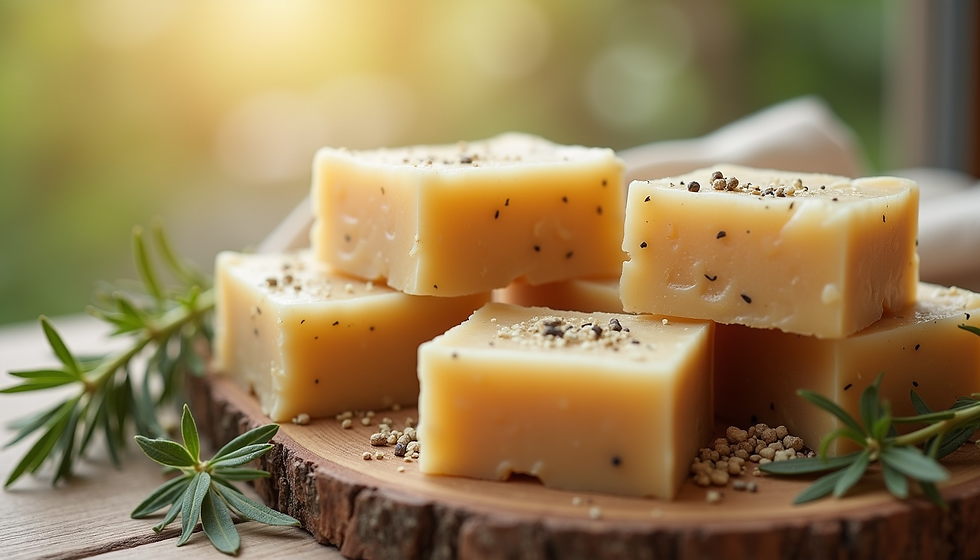Exploring the Craft of Handmade Soaps
- DeShawn Marie

- Apr 27
- 4 min read
In recent years, there's been a surge in the popularity of handmade soaps. This surge is not merely a trend; it's a testament to a growing appreciation for artisanal products that are crafted with care and intention. Handmade soaps offer unique scents and natural ingredients, making them a favorable alternative to commercial products. In this post, we will dive into the world of handmade soaps, exploring their benefits, the art of making them, and tips for those who want to embark on this creative journey.
The Benefits of Handmade Soaps
Choosing handmade soaps has numerous advantages over mass-produced alternatives. First, many commercially available soaps contain synthetic ingredients and harsh chemicals that can strip the skin of its natural oils. Handmade soaps, on the other hand, boast natural components such as essential oils and plant-based fats.
Skin-Friendly Ingredients: Most handmade soaps are made with olive oil, coconut oil, or shea butter. These ingredients are known for their moisturizing properties. For example, coconut oil can help to hydrate the skin and prevent dryness.
Customization: With handmade soaps, the possibilities are endless. You can create unique scents and customize your bars based on personal preferences or skin needs. Need a soap that helps with dryness? You can add aloe vera.
Environmental Sustainability: Many artisan soap makers focus on sourcing organic and eco-friendly ingredients. This means when people use handmade soaps, they are often supporting sustainable practices.

Getting Started With Handmade Soaps
Crafting your own handmade soaps can seem daunting, but with the right tools and techniques, anyone can dive into this enjoyable hobby. Here’s a basic outline of what you need to begin.
Gather Your Materials: The essential components include oils, lye, and distilled water. While lye might sound intimidating, it’s just sodium hydroxide, which transforms oils into soap through a chemical reaction.
Choose Your Recipe: If you're just starting, consider beginning with a simple recipe that requires few ingredients. Many online communities and resources, offer valuable recipes that cater to beginners.
Safety First: When working with lye, it's crucial to wear gloves and goggles to protect yourself. Always mix the lye with water outdoors or in a well-ventilated area.
Mixing and Pouring: Once you have your oils and lye prepared, mix them to create a soap batter. Once it reaches a light trace, pour it into molds. Let it cure for at least four weeks before using it.

Advanced Techniques in Soap Making
As you become more comfortable with the basics, you can begin to explore advanced techniques that can elevate your soaps.
Swirling Techniques: This involves pouring different colors of soap batter together and using a stick to create unique patterns. You can achieve beautiful designs that not only smell good but look stunning as well.
Layering: You can create layered soaps where each layer contains different scents or colors. This can be achieved by pouring one layer, allowing it to harden, and then pouring the next layer.
Inclusions: Consider adding natural exfoliants like oatmeal, coffee grounds, or dried flowers to your bars for added texture and benefits.
Scent Blending: Experiment with different essential oil combinations to develop your signature scent. Lavender and chamomile make a calming blend, while citrus oils can create an uplifting fragrance.

Common Mistakes to Avoid
Many beginners are eager to start crafting their own soaps, but a few common mistakes can hinder their progress. Here are some pitfalls and how to avoid them:
Skipping Safety Measures: Always prioritize safety by wearing protective gear. Mishaps can lead to injury, especially when handling lye.
Not Accurately Measuring Ingredients: Soap making is a science, and precise measurement is essential. Invest in a digital scale for accurate measurements.
Being Impatient: Allow your soap to cure properly. Cutting it too soon can lead to a product that is still caustic due to unreacted lye. Patience is key in the soap-making process.
Ignoring Recipes: While creativity is important, starting with established recipes helps you understand the chemistry of soap making better, allowing for successful experiments later.
The Future of Handmade Soaps
The interest in handmade soaps shows no signs of slowing down. Consumers are increasingly turning towards products that are made with love and care, reflecting a broader trend toward sustainability and wellness.
The handmade soap market is growing, integrating eco-friendly practices and personalized products. Innovations such as eco-friendly packaging and seasonal collections are becoming popular. As more people look for ways to reduce their environmental footprint, products like handmade soaps are increasingly sought after.
Getting Involved in the Soap-Making Community
If you are passionate about soap making, consider joining local or online communities where you can learn from others. These spaces can provide invaluable networking opportunities, workshops, and resources to continually sharpen your craft.
Remember, creating handmade soaps is not just about making a product; it's about connecting with a community of like-minded enthusiasts who share your passion.
Final Thoughts
Exploring the craft of handmade soaps can be a rewarding and fulfilling experience. Not only do you get to indulge in creativity but also create something beautiful and functional. With the right knowledge and enthusiasm, anyone can get started on this journey. So grab your materials, don your safety gear, and let your creativity flow into the world of handmade soaps!
By immersing yourself in this beautiful craft, you not only create products for personal use but also have the potential to share your creations with others, encouraging appreciation for the art of handmade soaps. If you are curious to deepen your knowledge or start your own venture, many resources await you!









Comments